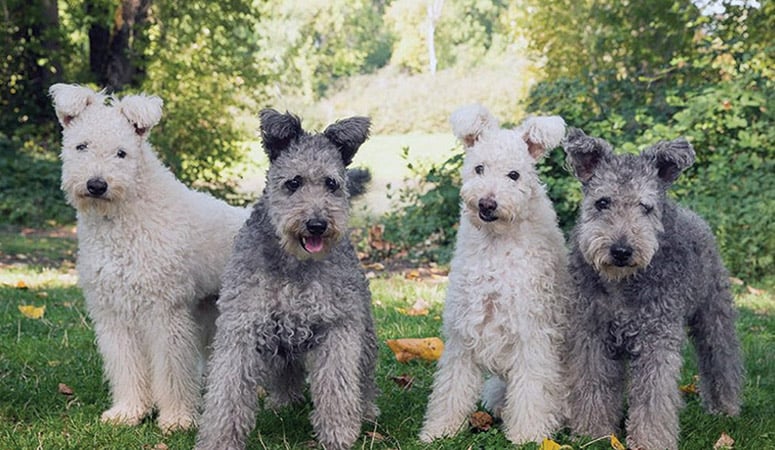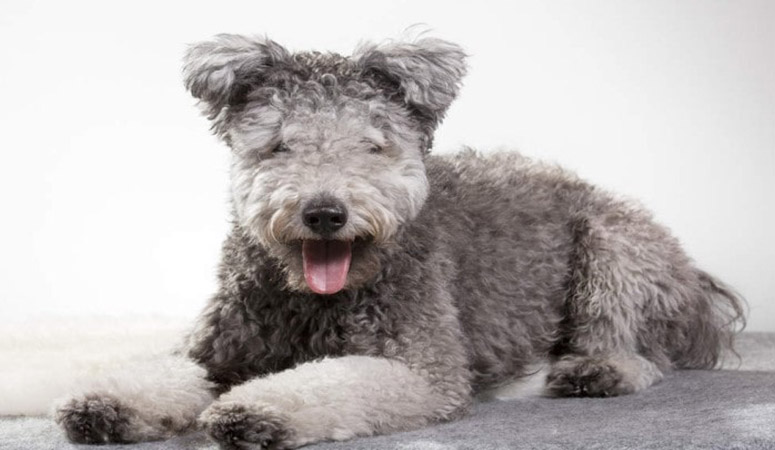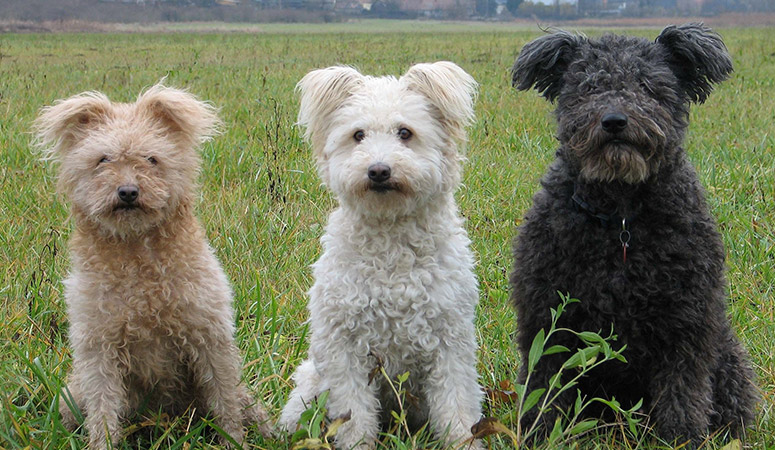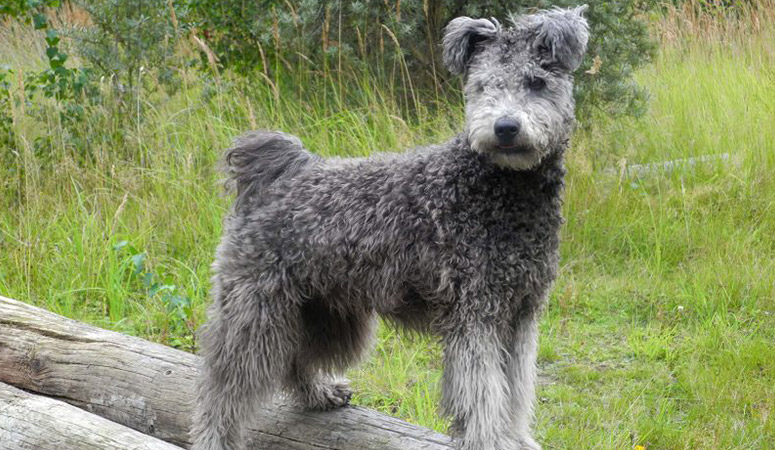Pumi
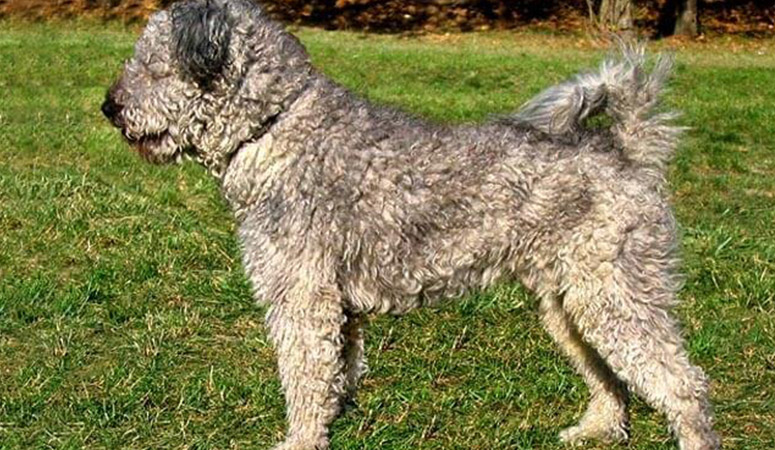
The Pumi was bred as a compact, quick, and fearless sheepherder with capacity for work and play, originated from western Hungary. He has a corkscrew-curled coat, circular tail, expressive ears, and distinctively whimsical look, which make him look so cute. With intelligence, agility, and boldness, this breed is used to herd, and they are skilled at gathering, driving and keeping livestock within its boundaries as directed by the shepherd.
| Other Names | Hungarian Pumi, Hungarian herding terrier |
| Color | Black, Fawn, Gray, Silver Gray, White, Born Brown, Born Gray |
| Height | Male: 16-18.5 inches, Female: 15-17.5 inches. |
| Weight | Male: 27-29 pounds, Female: 22-24 pounds. |
| Life Span | 12-13 years |
| Personality | Energetic, Lively, Ready to Work |
| Exercise | Needs Lots of Activity |
| Origin |
| Popularity | #156 |
| Groom Needs | Occasional Bath/Brush |
| Kids Friendly | Yes with supervision |
| Dog Friendly | Yes with supervision |
| Watch Dog | Yes |
| Family Dog | Yes |
| Litter Size | 4–6 puppies |
Pumi Pictures
Pumi Video
Introduction
An active member of the family; bold, cheerful, and intelligent. Pumik know when to bark and when to pay close attention to their surroundings. They are expressive, and when they dislike a stranger, it is noticeable. The Pumi is a square-built and light dog, with a long and narrow head. Pumik appear large (strutting with an energetic deportment), thanks to their thick coat.
Pumik come in a thick double coat, the topcoat of which is harsh in contrast to its soft undercoat providing adequate insulation from harsh weather. They require regular brushing and grooming. The usual coat colors are gray, black, fawn, or white, with gray Pumik being the most common.
A standard Pumi is a small- to medium-sized dog, males of which should measure 16-19 inches at the shoulder, and weigh 27-29 pounds. The females are of a similar stock, although slightly smaller, standing 15-18 inches at the shoulder and tipping the weighing scales at around 22-24 pounds. They are members of the Herding Group and have an average life expectancy of 11-13 years.
Living with Pumi
The Pumi’s coat — half soft hair, half harsher hair — doesn’t shed much, but hair will come out during grooming. The Pumi doesn’t need frequent baths, but if he spends a lot of time on your furniture or bed, you may want to bathe him monthly.
He needs combing every three to six weeks to remove mats or debris, followed by a good wetting-down to let the coat curl back up. Never blow it dry, or it will look fluffy instead of curly. Once curled, the coat can be trimmed to keep it looking tidy. Trimming is usually only necessary every three months or so. You may want to find a reliable groomer when it’s time for trimming.
Trim the nails every three to four weeks, or as needed to prevent cracking.
Check the Pumi’s ears weekly for signs of infection, including redness and an unpleasant odor. Wash their ears gently with a dog-friendly cleanser to prevent dirt build-up that can cause infections.
Brush the teeth often with a vet-approved pet toothpaste, which can help keep overall health and fresh breath.
With high energy and keen intelligence, the Pumi requires regular exercise to keep him physically and mentally stimulated.
The Pumi isn’t a breed for the couch potato. Happiest on a farm or in a rural area, this dog needs to be put to work, and excels at guarding and tending livestock and guarding animals and property. He likes to be outside, so make sure he’s got plenty of room to run around. They’re also quite agile and will climb over and under things, and they love to be in high places to see what’s going on.
If you live in an urban area, you need to keep your Pumi occupied. Great activities for this dog include walking, hiking and jogging.
The breed enjoys games of retrieving tennis balls or flying discs, and a Pumi is likely to demand a good chase-and-fetch game with these. They also excels in agility, obedience and other dog sports.
Pumik are also quite agile and will climb over and under things, and they love to be in high places to see what’s going on. Always make sure that this dog obeys the heel command, as it is important for you to be viewed as the leader.
The Pumi is a hear working and energetic dog, so he will need high-quality dog food to keep up with his high activity level. A premium dry food that contains quality proteins and fats is recommended for this breed.
Any diet should be appropriate to the dog’s age, size, activity level and metabolism. The quality of dog food you buy also makes a difference — the better the dog food, the further it will go toward nourishing your dog and the less of it you’ll need to shake into your dog’s bowl. Talk to your veterinarian about the optimal diet and quantity of food for your Pumi.
Some dogs are prone to getting overweight, so watch your dog’s calorie consumption and weight level. Treats can be an important aid in training, but giving too many can cause obesity.
Clean, fresh water should be available at all times.
Learn about which human foods are safe for dogs, and which are not. Check with your vet if you have any concerns about your dog’s weight or diet.
The Pumi is regarded by most breeders and veterinarians as a healthy breed, with an average life expectancy of 12 to 14 years. But it does have a few potential health predispositions, including hip dysplasia, Degenerative Myelopathy, Elbow Dysplasia, luxating or floating patellas and primary lens luxation (PLL).
Of course, environmental and other factors can contribute to each of these conditions. Not all Pumik will get any or all of these diseases, but it’s important to be aware of them if you’re considering this breed.
As with all breeds, the Pumi’s ears should be checked regularly for signs of infection, and the teeth should be brushed often, ideally every day, using a toothpaste formulated for dogs.
There are several health tests considerations specific to the breed, such as patella evaluation, PLL DNA test, degenerative myelopathy DNA test and hip evaluation. The breed’s gene pool is not large, so canine Leukocyte Adhesion Deficiency DNA test is especially important.
Responsible breeders test all breeding stock for conditions that can affect the breed. Regular visits to the vet for checkups and parasite control help to ensure the dog a long, healthy life.
Total Annual Cost: $2889
Cost is estimated for the first year and may vary depending on many factors, such as dog food, health care, leash, collar, licensing, possible fencing, crates, training and obedience classes, dog-walking, grooming, treats, toys, flea, tick, and heart-worm meds, microchips, etc.
Because this is intelligent, he takes to training easily. After mastering the basics, do not be afraid to move onto more challenging tasks. A Pumi will learn quickly and has a boundless willingness to work without being obsessive about it.
The Pumi is a thinking dog who must assess each new situation, so it is vital for the breed to have early socialization as puppies.
The Pumi was originally used as a herding dog and most working sheepdogs in Hungary. Today many are used for agility, dancing, and obedience. They also can be trained for detection, search and rescue, and other purposes. Because Pumik enjoy using their voices, barking should not be reinforced.
Alert, watchful and intelligent, the Pumi will quickly take advantage of the situation if he senses that his owner is a pushover, which will make the dog willful and cause major disruption in the household.
You need to become the dominant head of the family and make the decisions and rules to ensure that your dog knows his place in the pecking order and follows the rules.
History
Pumik is the plural form for Pumi in Hungarian. The Pumi is a Hungarian sheepdog breed closely related to the Puli, which is longer-haired. Its ancestry may date back to the Magyars migration from Central Asia. It is believed by many that the Puli which gave rise to the Pumi can be traced to the ancient Tibetan Terrier, the Tsang Apso about a millennium ago. However, according to some accounts, the Puli was later crossed with the French breed, Briard, and the German Spitz dogs. Historians have decided that the Pumi was developed without intent to do so, even listing the German Pomeranian amongst dog breeds that formed a foundation stock for the Pumi with crosses occurring between the 1600s and 1700s. Other reports claim that the shorter coats of the Pumi were probably as a result of a cross with the Pyrenean Mountain Dog.
As the breeding of indigenous dog breeds was dissuaded in 19th century Hungary, the native Sheepdogs were not distinguished into breeds yet till around 1902, when they were classified mainly into three on the basis of physical attributes and regions they occupy– Pumik being common in western Hungary, the Puli in the east and the Mudi in the south. Breeding of these sheepdogs set sail and shipped off but was forestalled shortly during World War I, decreasing the population of Pumik along the line. However, after the war, Dr. Emil Raitsits drafted the first breeding standard for Pumik in 1921, in which he described them as sheepdog terriers. The official separation of the Pumi and Puli occurred in 1927.
The standard was later accepted by the FCI in 1935. The official recognition of Pumik by the American Kennel Club (AKC) happened in 2016.
Helpful Information
Breed Club: HUNGARIAN PUMI CLUB OF AMERICA
Breed Club Link: http://pumiclub.org/
Breed Club Rescue:

